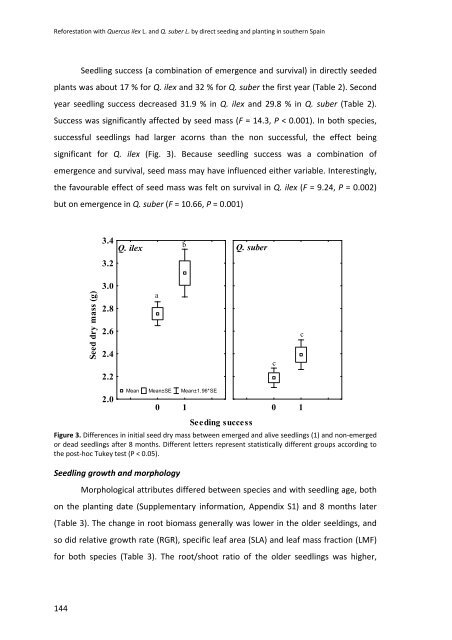Establecimiento de cuatro especies de Quercus en el sur de la ...
Establecimiento de cuatro especies de Quercus en el sur de la ...
Establecimiento de cuatro especies de Quercus en el sur de la ...
Create successful ePaper yourself
Turn your PDF publications into a flip-book with our unique Google optimized e-Paper software.
Reforestation with <strong>Quercus</strong> ilex L. and Q. suber L. by direct seeding and p<strong>la</strong>nting in southern Spain<br />
Seedling success (a combination of emerg<strong>en</strong>ce and <strong>sur</strong>vival) in directly see<strong>de</strong>d<br />
p<strong>la</strong>nts was about 17 % for Q. ilex and 32 % for Q. suber the first year (Table 2). Second<br />
year seedling success <strong>de</strong>creased 31.9 % in Q. ilex and 29.8 % in Q. suber (Table 2).<br />
Success was significantly affected by seed mass (F = 14.3, P < 0.001). In both species,<br />
successful seedlings had <strong>la</strong>rger acorns than the non successful, the effect being<br />
significant for Q. ilex (Fig. 3). Because seedling success was a combination of<br />
emerg<strong>en</strong>ce and <strong>sur</strong>vival, seed mass may have influ<strong>en</strong>ced either variable. Interestingly,<br />
the favourable effect of seed mass was f<strong>el</strong>t on <strong>sur</strong>vival in Q. ilex (F = 9.24, P = 0.002)<br />
but on emerg<strong>en</strong>ce in Q. suber (F = 10.66, P = 0.001)<br />
3.4<br />
Q. ilex<br />
b<br />
Q. suber<br />
3.2<br />
Seed dry mass (g)<br />
3.0<br />
2.8<br />
2.6<br />
2.4<br />
a<br />
c<br />
c<br />
2.2<br />
2.0<br />
Mean Mean±SE Mean±1.96*SE<br />
0 1<br />
Seeding success<br />
0 1<br />
Figure 3. Differ<strong>en</strong>ces in initial seed dry mass betwe<strong>en</strong> emerged and alive seedlings (1) and non‐emerged<br />
or <strong>de</strong>ad seedlings after 8 months. Differ<strong>en</strong>t letters repres<strong>en</strong>t statistically differ<strong>en</strong>t groups according to<br />
the post‐hoc Tukey test (P < 0.05).<br />
Seedling growth and morphology<br />
Morphological attributes differed betwe<strong>en</strong> species and with seedling age, both<br />
on the p<strong>la</strong>nting date (Supplem<strong>en</strong>tary information, App<strong>en</strong>dix S1) and 8 months <strong>la</strong>ter<br />
(Table 3). The change in root biomass g<strong>en</strong>erally was lower in the ol<strong>de</strong>r se<strong>el</strong>dings, and<br />
so did r<strong>el</strong>ative growth rate (RGR), specific leaf area (SLA) and leaf mass fraction (LMF)<br />
for both species (Table 3). The root/shoot ratio of the ol<strong>de</strong>r seedlings was higher,<br />
144

















